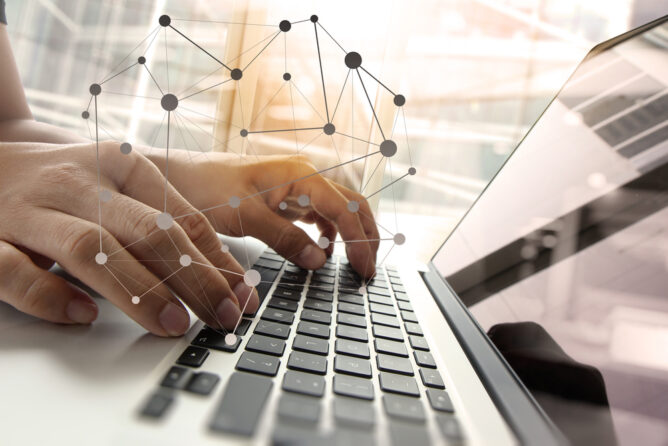As organizations continue to shift and adapt to the ever-changing workplace dynamic, technology has become a necessary asset to reach managerial goals. Not only are more employees working remotely and requesting a flexible work environment, expectations of human resources (HR) including the ability to keep up with employee relations (ER) are increasingly apparent. As the current workforce becomes more comfortable with moving from one company to another until they find the perfect fit, losing out on effective employee relations could result in an unhappy team and an increase in turnover.
The Society for Human Resource Management (SHRM) says HR managers must master both traditional HR skills as well as have the knowledge to successfully transform their organization via optimized technology.
An Overview of Human Resource Technology
 As the world becomes more and more technologically driven, HR and ER departments are adapting to these changes. Human resources technology is becoming increasingly prevalent as a way to streamline processes and make them more efficient.
As the world becomes more and more technologically driven, HR and ER departments are adapting to these changes. Human resources technology is becoming increasingly prevalent as a way to streamline processes and make them more efficient.
Technology has changed the way we work. It’s no longer just a tool that is used by an HR professional but it has become an integral part of their job. HR managers are now using technology to find, attract and retain talent as well as develop strategic management techniques that can mold and streamline training, retention, employee engagement and more. Through the use of cloud-based HR software, it’s easy for employees to access their information and engage with managers and other team members from anywhere.
Digital HR is transforming human resources in multiple ways:
- Organizations that use HR software outperform those that don’t, says SHRM.
- Reducing the cost of HR administration.
- Provides a foundation to compete for talent in a more realistic and measurable way.
- The power of data can be used to make better decisions and be more efficient.
- ER management can improve employee engagement and workplace culture, enhancing customer service and output in the process.
While HR technology has helped businesses to be more productive, it has also given employees the ability to have improved work-life balance and happier working conditions. Some of the most common HR technology tools used within employee relations include HR case management software and workplace investigations software.
The benefits and drawbacks of technology for HR managers
HR technologies allow companies to maintain better employee relations by providing tools that foster equitable and transparent work environment with clear and transparent processes and give leaders the tools and data they need to keep decisions fair.
Technology has become a staple in the workplace, with many people using it to make their work easier. However, there are some people who believe that technology is taking away from the human element – Is HR tech taking the “human” out of “human resources”? In reality, however, the human component of HR can be nurtured far better through technology.
HR technology is not just about automating tasks that are repetitive or mundane but gaining visibility into what’s happening across the business and empowering people leaders with efficient processes, easy workflows and the tools to get employee relations right every time. And, when HR and ER managers get to spend less time focusing on spreadsheets and data entry, they can better foster connections and build practical strategies for promoting strong employee relationships.
Communication itself has its benefits – but also a possible pitfall – when technology becomes a standard in the workplace. Yes, interactions can see an improvement because employees can communicate more quickly and transfer ideas through the use of technology such as sharing screens and utilizing team platforms. However, communication via smartphones and other devices eliminates the need for face-to-face contact. One huge component in employee relations – interpersonal relations – has the potential to be forgotten. Human resource managers, therefore, need to continue to build relationships with employees and promote an environment where employees engage with one another in a space that isn’t always virtual.
The latest trends in human resource technology
HR professionals are continuing to innovate their management practices through the strategic implementation of digital tools and software. HR managers are leveraging technology to build strong relationships with employees and the trends have changed even over a few short years.
The rise of artificial intelligence
AI and ML have been used or will be used by up to 50% of organizations by the end of 2022. This number was only about 17% in 2021. So why is AI such an excellent tool for HR managers? The use of AI has led to faster, more accurate insights into employee performance, helping HR managers make better decisions in the long run and reduce the risk of mistakes or issues later on. Administrative tasks that once took hours are not automatically completed by digital assistants within seconds, leaving time open for managers to focus on employee engagement and other critical job duties that might otherwise have been overlooked.
The need for purpose-built platforms
We’ve said it before, purpose-built platforms are a critical component of employee relations. Instead of being an afterthought, all the data and insights needed to actively and successfully manage employee relations are in one central, easy-to-navigate space. Why is this important? Amid the unpredictable workplace environment and beyond, having a tech-based platform like HR Acuity’s employee relations solutions make it easy to optimize the latest in ER technology to foster strong relationships across all levels of the organization.
Employee self-service (ESS) resources
According to SHRM, 90% of businesses plan to implement self-service applications for their employees. These platforms, which are often web-based, allow employees to manage HR issues and questions on their own. Employees are happier and have stronger relationships with management because they don’t have to seek out solutions to their HR and ER-related problems. This frees up time for managers to focus on the pressing issues that employees can’t handle on their own, so wait times for help are lowered. In fact, HR headcount is often decreased by up to 25% with an effective ESS system in place.
Digital workplace issue management software
There is no perfect workplace, and issues are going to happen when people come to work together in any kind of setting. Technology has been adapted to include tools that can predict and resolve organizational issues before they turn into full-blown problems. By taking a proactive approach to issue management – with the help of AI and communication-based solutions – organizations can help to prevent expensive and time-consuming investigations from occurring. HR Acuity provides a platform to address employee issues with built-in intelligence and reporting that strengthens performance management.
Optimizing technology to manage employees more effectively
If you’ve made the decision to begin implementing more HR technology into your organization, there are some first steps you can take. Rather than paying the cost of establishing a framework for digital transformation in-house, working with an experienced external team can provide a starting point that will begin benefiting your company in a short period of time. You can optimize HR software as an integrated solution for your employee relations and human resource management strategy.
HR software is a powerful tool for managers who need to keep track of their employees and manage their workload efficiently. By streamlining their workforce management process, companies can improve employee engagement and productivity and gain insight into multiple data points, from employee satisfaction to potential conflicts.
Request a free demo or contact us to learn more about how HR Acuity software can help you streamline your employee management practices.




